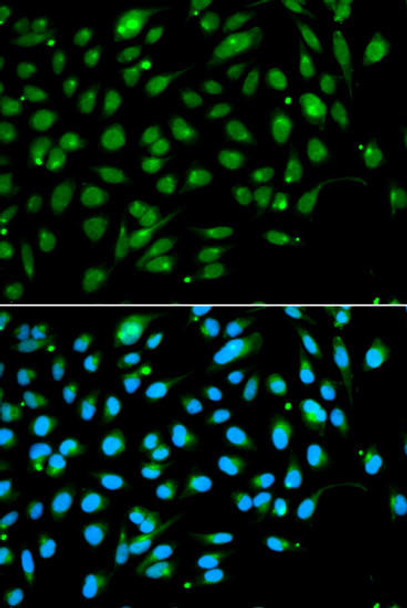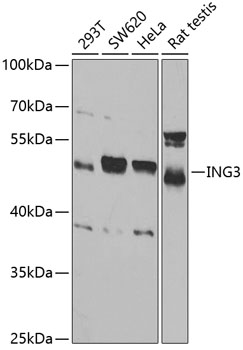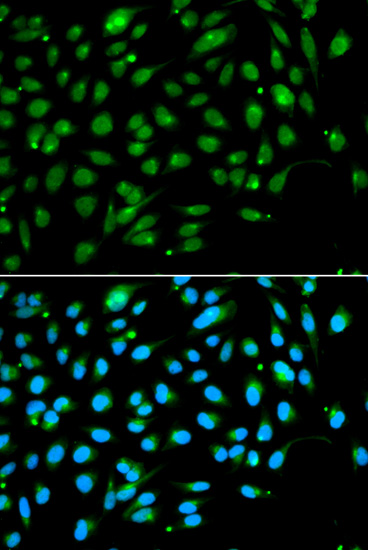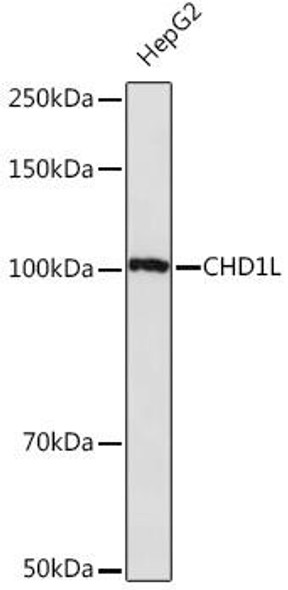Anti-ING3 Antibody (CAB5832)
- SKU:
- CAB5832
- Product type:
- Antibody
- Reactivity:
- Human
- Mouse
- Rat
- Host Species:
- Rabbit
- Isotype:
- IgG
- Antibody Type:
- Polyclonal Antibody
- Research Area:
- Developmental Biology
Frequently bought together:
Description
| Antibody Name: | Anti-ING3 Antibody |
| Antibody SKU: | CAB5832 |
| Antibody Size: | 20uL, 50uL, 100uL |
| Application: | WB IF |
| Reactivity: | Human, Mouse, Rat |
| Host Species: | Rabbit |
| Immunogen: | Recombinant fusion protein containing a sequence corresponding to amino acids 1-92 of human ING3 (NP_938008.1). |
| Application: | WB IF |
| Recommended Dilution: | WB 1:500 - 1:2000 IF 1:50 - 1:200 |
| Reactivity: | Human, Mouse, Rat |
| Positive Samples: | 293T, SW620, HeLa, Rat testis |
| Immunogen: | Recombinant fusion protein containing a sequence corresponding to amino acids 1-92 of human ING3 (NP_938008.1). |
| Purification Method: | Affinity purification |
| Storage Buffer: | Store at -20°C. Avoid freeze / thaw cycles. Buffer: PBS with 0.02% sodium azide, 50% glycerol, pH7.3. |
| Isotype: | IgG |
| Sequence: | MLYL EDYL EMIE QLPM DLRD RFTE MREM DLQV QNAM DQLE QRVS EFFM NAKK NKPE WREE QMAS IKKD YYKA LEDA DEKV QLAN QIYD LQHF |
| Gene ID: | 54556 |
| Uniprot: | Q9NXR8 |
| Cellular Location: | Nucleus |
| Calculated MW: | 11kDa/46kDa |
| Observed MW: | 50kDa |
| Synonyms: | ING3, Eaf4, ING2, MEAF4, p47ING3 |
| Background: | The protein encoded by this gene is similar to ING1, a tumor suppressor protein that can interact with TP53, inhibit cell growth, and induce apoptosis. This protein contains a PHD-finger, which is a common motif in proteins involved in chromatin remodeling. This gene can activate p53 trans-activated promoters, including promoters of p21/waf1 and bax. Overexpression of this gene has been shown to inhibit cell growth and induce apoptosis. Allelic loss and reduced expression of this gene were detected in head and neck cancers. Two alternatively spliced transcript variants encoding different isoforms have been observed. |
| UniProt Protein Function: | ING3: Component of the NuA4 histone acetyltransferase (HAT) complex which is involved in transcriptional activation of select genes principally by acetylation of nucleosomal histones H4 and H2A. This modification may both alter nucleosome - DNA interactions and promote interaction of the modified histones with other proteins which positively regulate transcription. This complex may be required for the activation of transcriptional programs associated with oncogene and proto-oncogene mediated growth induction, tumor suppressor mediated growth arrest and replicative senescence, apoptosis, and DNA repair. NuA4 may also play a direct role in DNA repair when directly recruited to sites of DNA damage. Defects in ING3 may be a cause of head and neck squamous cell carcinomas (HNSCC); also known as squamous cell carcinoma of the head and neck. Belongs to the ING family. 3 isoforms of the human protein are produced by alternative splicing. |
| UniProt Protein Details: | Protein type:Transcription, coactivator/corepressor Chromosomal Location of Human Ortholog: 7q31 Cellular Component: nucleoplasm; NuA4 histone acetyltransferase complex; cytoplasm; nucleolus; nucleus Molecular Function:histone acetyltransferase activity; zinc ion binding; methylated histone residue binding Biological Process: establishment and/or maintenance of chromatin architecture; regulation of transcription, DNA-dependent; transcription, DNA-dependent; positive regulation of apoptosis; regulation of growth |
| NCBI Summary: | The protein encoded by this gene is similar to ING1, a tumor suppressor protein that can interact with TP53, inhibit cell growth, and induce apoptosis. This protein contains a PHD-finger, which is a common motif in proteins involved in chromatin remodeling. This gene can activate p53 trans-activated promoters, including promoters of p21/waf1 and bax. Overexpression of this gene has been shown to inhibit cell growth and induce apoptosis. Allelic loss and reduced expression of this gene were detected in head and neck cancers. Two alternatively spliced transcript variants encoding different isoforms have been observed. [provided by RefSeq, Jul 2008] |
| UniProt Code: | Q9NXR8 |
| NCBI GenInfo Identifier: | 59798432 |
| NCBI Gene ID: | 54556 |
| NCBI Accession: | Q9NXR8.2 |
| UniProt Related Accession: | Q9NXR8 |
| Molecular Weight: | 50kDa |
| NCBI Full Name: | Inhibitor of growth protein 3 |
| NCBI Synonym Full Names: | inhibitor of growth family member 3 |
| NCBI Official Symbol: | ING3 |
| NCBI Official Synonym Symbols: | Eaf4; ING2; MEAF4; p47ING3 |
| NCBI Protein Information: | inhibitor of growth protein 3 |
| UniProt Protein Name: | Inhibitor of growth protein 3 |
| UniProt Synonym Protein Names: | p47ING3 |
| Protein Family: | Inhibitor of growth protein |
| UniProt Gene Name: | ING3 |
| UniProt Entry Name: | ING3_HUMAN |









